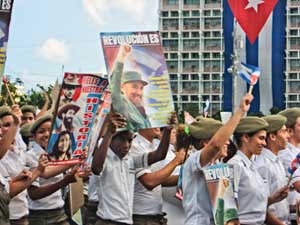‘All for the Revolution!’
International delegations stand with Cuba on May Day
By
Cheryl LaBash
Havana, Cuba
Published May 13, 2009 1:44 PM
First-time visitors from the U.S. were unsure what the day would hold as they
watched dawn break in Revolution Square on May Day morning.
The international delegations—more than 2,000 in all from 70 countries,
including union leaders and revolutionaries, often both in the same person, and
representing 200 union and solidarity organizations—streamed off buses
and into the reviewing area at the foot of the José Martí statue.
|
Havana May Day.
WW photos: Cheryl LaBash
|
They chatted, chanted and taped their banners to the walls displaying the
international demand to free the five Cuban heroes imprisoned in the U.S. as
they waited for the program and march to begin. It was a global echo of the
message President Barack Obama received at the recent Summit of the Americas:
End the blockade! Cuba is not alone, and U.S. imperialism is not
invincible!
“Why are there so few people in the Plaza?” one
queried—before the Cuban workers marched in, wave after wave, for hours.
“Will Cuban President Raul Castro speak?” A cheer greeted Castro
when he appeared, but it was the Confederation of Cuban Workers [Central de
Trabajadores de Cuba—CTC] General-Secretary Salvador Valdés Mesa who
addressed the International Workers’ Day event in Havana, as is customary
on May Day.
This May Day was the 50th since the 1959 revolution broke free of the colonial
past and charted a path of development to meet peoples’ needs instead of
profit and exploitation. It also marked the 70th anniversary of the founding of
the CTC, which has been instrumental, side-by-side with the Communist Party of
Cuba, in developing workers’ power.
And it was the workers and youth who marched in Havana with the theme of unity,
combativeness, productivity and efficiency. They carried representations of
their workplaces such as a huge cigar from the La Corona factory, a taxi,
housing construction brigades with tools, and pictures of rebuilding the
500,000 dwellings destroyed by the three hurricanes suffered in 2008.
Gigantic Cuban and Venezuelan flags, supported by hundreds of youth, undulated
like ocean waves. Multiple massive delegations from the UJC Communist Youth
Union [Unión de Jóvenes Comunistas] marched with the message:
“The youth will not fail. All for the revolution!” Gymnasts and
professional dancers, fresh and energetic, entered the square. Handmade signs
demanded freedom for the Cuban Five, saluted and supported Cuban leaders Fidel
and Raul, and saluted socialism.
|
Cubans carry banner on May Day that says
“Workers--we decide and direct
our socialism.”
|
Delores Lemon-Thomas, visiting from Richmond, Calif., recalled marching around
the White House protesting the U.S. invasions of Iraq and Afghanistan and
seeing heavily armed troops burdened with body armor along with rooftop
snipers, as well as police phalanxes controlling San Francisco protests. She
noted she was only a few hundred feet away from the Cuban president and that,
with hundreds of thousands marching in the street, only unarmed youth gently
encouraged the marchers not to stop to take pictures at the José
Martí monument.
Another example of the contrast between life witnessed in Cuba and experienced
in the U.S. was expressed on May Day by CTC leader Salvador Valdés Mesa,
who spoke of the global economic crisis and supported the Cuban
government’s efforts “to protect the people from the effects of the
crisis.
“Even more so, at a time when humanity is immersed in a global economic
crisis making the political, economic and social situation more complex
globally, this impacts on the people, and workers face bleak prospects from
which no country can escape.
“In our case, this is compounded by the effects of the ironclad economic
blockade that the U.S. government has maintained for almost half a century,
with the obsessive and failed object of destroying the Revolution.
“The unity and resistance in the face of any obstacle, which Fidel has
formed within us, are pillars on which the Cuban Revolution is triumphantly
erected and have become the central and constant battle flags. We will continue
supporting with determination the measures that our government adopts to reduce
the effects of the crisis on the population.”
And that is the profound difference between a social system based on
capitalism, with its profits for banks and corporations, and socialism.
Articles copyright 1995-2012 Workers World.
Verbatim copying and distribution of this entire article is permitted in any medium without royalty provided this notice is preserved.
Workers World, 55 W. 17 St., NY, NY 10011
Email:
[email protected]
Subscribe
[email protected]
Support independent news
DONATE


